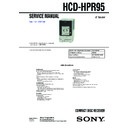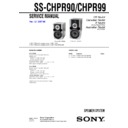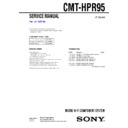Read Sony CMT-HPR95 / HCD-HPR95 Service Manual online
SERVICE MANUAL
Model Name Using Similar Mechanism
HCD-HPR90
CD Mechanism Name
DLM5B
Base Unit Name
BU-K6BD83S-WOD
Optical Pick-Up Block Name
KSM-213DCP
COMPACT DISC RECEIVER
HCD-HPR95
SPECIFICATIONS
9-887-575-01
2007B05-1
© 2007.02
© 2007.02
Sony Corporation
Personal Audio Division
Published by Sony Techno Create Corporation
Published by Sony Techno Create Corporation
• HCD-HPR95 is the amplifier, CD player and
tuner section in CMT-HPR95.
US and foreign patents licensed from Dolby Laboratories.
Ver. 1.0 2007.02
E Model
Amplifier section
The following measured at AC 127 V, 60 Hz (Mexican model),
AC 220 – 240 V, 50/60 Hz (Other models)
AC 220 – 240 V, 50/60 Hz (Other models)
DIN power output (rated): 56 + 56 W (4 ohms at 1 kHz, DIN)
Continuous RMS power output (reference): 70 + 70 W (4 ohms at 1 kHz,
10% THD)
Continuous RMS power output (reference): 70 + 70 W (4 ohms at 1 kHz,
10% THD)
Inputs
AUDIO IN: Sensitivity 250 mV, impedance of 47 kilohms
Outputs
PHONES (stereo mini jack): accepts headphones with an impedance of 8
ohms or more
SPEAKER: accepts impedance of 4 ohms
ohms or more
SPEAKER: accepts impedance of 4 ohms
CD player section
System: Compact disc and digital audio system
Laser Diode Properties
Laser Diode Properties
Emission Duration: Continuous
Laser Output*: Less than 44.6
Laser Output*: Less than 44.6
µW
* This output is the value measurement at a distance of 200 mm from the
objective lens surface on the Optical Pick-up Block with 7 mm aperture.
Frequency response: 20 Hz – 20 kHz (
±2 dB)
Wavelength: 780 – 790 nm
Tuner section
FM stereo, FM/AM superheterodyne tuner
FM tuner section:
FM tuner section:
Tuning range: 87.5 – 108.0 MHz
Antenna: FM lead antenna
Antenna terminals: 75 ohms unbalanced
Intermediate frequency: 10.7 MHz
Antenna: FM lead antenna
Antenna terminals: 75 ohms unbalanced
Intermediate frequency: 10.7 MHz
AM tuner section:
Tuning range
Tuning range
530 – 1,710 kHz (with 10 kHz tuning interval)
531 – 1,602 kHz (with 9 kHz tuning interval)
531 – 1,602 kHz (with 9 kHz tuning interval)
Antenna: AM loop antenna
Antenna terminals: External antenna terminal
Intermediate frequency: 450 kHz
Antenna terminals: External antenna terminal
Intermediate frequency: 450 kHz
General
Power requirements
Mexican model: 127 V AC, 60 Hz
Other models: 220 – 240 V AC, 50/60 Hz
Adjustable with voltage selector
Other models: 220 – 240 V AC, 50/60 Hz
Adjustable with voltage selector
Power consumption: 45 watts
Dimensions (w/h/d) (excl. speakers): Approx. 180
× 280 × 360 mm
Mass (excl. speakers): 3.9 kg
Design and specifications are subject to change without notice.
2
HCD-HPR95
Notes on chip component replacement
•
Never reuse a disconnected chip component.
•
Notice that the minus side of a tantalum capacitor may be
damaged by heat.
Flexible Circuit Board Repairing
•
Keep the temperature of the soldering iron around 270 ˚C
during repairing.
•
Do not touch the soldering iron on the same conductor of the
circuit board (within 3 times).
•
Be careful not to apply force on the conductor when soldering
or unsoldering.
CAUTION
Use of controls or adjustments or performance of procedures
other than those specified herein may result in hazardous radiation
exposure.
other than those specified herein may result in hazardous radiation
exposure.
ATTENTION AU COMPOSANT AYANT RAPPORT
À LA SÉCURITÉ!
LES COMPOSANTS IDENTIFIÉS PAR UNE MARQUE
0
SUR
LES DIAGRAMMES SCHÉMATIQUES ET LA LISTE DES
PIÈCES SONT CRITIQUES POUR LA SÉCURITÉ DE
FONCTIONNEMENT. NE REMPLACER CES COM- POSANTS
QUE PAR DES PIÈCES SONY DONT LES NUMÉROS SONT
DONNÉS DANS CE MANUEL OU DANS LES SUPPLÉMENTS
PUBLIÉS PAR SONY.
PIÈCES SONT CRITIQUES POUR LA SÉCURITÉ DE
FONCTIONNEMENT. NE REMPLACER CES COM- POSANTS
QUE PAR DES PIÈCES SONY DONT LES NUMÉROS SONT
DONNÉS DANS CE MANUEL OU DANS LES SUPPLÉMENTS
PUBLIÉS PAR SONY.
TABLE OF CONTENTS
1.
SERVICING NOTES
...............................................
3
2.
GENERAL
...................................................................
4
3.
DISASSEMBLY
3-1.
Disassembly Flow ...........................................................
6
3-2.
Case .................................................................................
7
3-3.
Back Panel .......................................................................
7
3-4.
MAIN Board ....................................................................
8
3-5.
AMP Board, POWER Board Block ................................
8
3-6.
Front Panel Block, CD Mechanical (DLM5B) ...............
9
3-7.
Belt (DLM3A) ................................................................. 10
3-8.
Optical Pick-Up Block .................................................... 10
4.
TEST MODE
.............................................................. 11
5.
ELECTRICAL CHECKS
........................................ 13
6.
DIAGRAMS
6-1.
Block Diagram – CD SERVO Section – ......................... 14
6-2.
Block Diagram – AUDIO Section – ................................ 15
6-3.
Block Diagram
– PANEL, POWER SUPPLY Section – .......................... 16
– PANEL, POWER SUPPLY Section – .......................... 16
6-4.
Printed Wiring Board – CD Board – ............................... 18
6-5.
Schematic Diagram – CD Board – .................................. 19
6-6.
Printed Wiring Board – MAIN Board – .......................... 20
6-7.
Schematic Diagram – MAIN Board (1/3) – .................... 21
6-8.
Schematic Diagram – MAIN Board (2/3) – .................... 22
6-9.
Schematic Diagram – MAIN Board (3/3) – .................... 23
6-10. Printed Wiring Board – AMP Board – ............................ 24
6-11. Schematic Diagram – AMP Board – ............................... 25
6-12. Printed Wiring Board – PANEL Board – ........................ 26
6-13. Printed Wiring Boards – FL Section – ............................ 27
6-14. Schematic Diagram – PANEL Section – ......................... 28
6-15. Schematic Diagram – FL Board – ................................... 29
6-16. Printed Wiring Board – POWER Board – ....................... 30
6-17. Schematic Diagram – POWER Board – .......................... 31
6-11. Schematic Diagram – AMP Board – ............................... 25
6-12. Printed Wiring Board – PANEL Board – ........................ 26
6-13. Printed Wiring Boards – FL Section – ............................ 27
6-14. Schematic Diagram – PANEL Section – ......................... 28
6-15. Schematic Diagram – FL Board – ................................... 29
6-16. Printed Wiring Board – POWER Board – ....................... 30
6-17. Schematic Diagram – POWER Board – .......................... 31
7.
EXPLODED VIEWS
7-1.
Overall Section ................................................................ 45
7-2.
Front Panel Section ......................................................... 46
7-3.
AMP Board, POWER Board Section .............................. 47
7-4.
CD Mechanical Section (DLM5B) .................................. 48
8.
ELECTRICAL PARTS LIST
................................ 49
4HIS
3
HCD-HPR95
MODEL IDENTIFICATION
MODEL
PART No.
E model
3-094-267-0[]
Mexican model
3-094-267-1[]
The laser diode in the optical pick-up block may suffer electrostatic
break-down because of the potential difference generated by the
charged electrostatic load, etc. on clothing and the human body.
During repair, pay attention to electrostatic break-down and also
use the procedure in the printed matter which is included in the
repair parts.
The flexible board is easily damaged and should be handled with
care.
break-down because of the potential difference generated by the
charged electrostatic load, etc. on clothing and the human body.
During repair, pay attention to electrostatic break-down and also
use the procedure in the printed matter which is included in the
repair parts.
The flexible board is easily damaged and should be handled with
care.
NOTES ON LASER DIODE EMISSION CHECK
The laser beam on this model is concentrated so as to be focused on
the disc reflective surface by the objective lens in the optical pick-
up block. Therefore, when checking the laser diode emission,
observe from more than 30 cm away from the objective lens.
The laser beam on this model is concentrated so as to be focused on
the disc reflective surface by the objective lens in the optical pick-
up block. Therefore, when checking the laser diode emission,
observe from more than 30 cm away from the objective lens.
NOTES ON HANDLING THE OPTICAL PICK-UP
BLOCK OR BASE UNIT
BLOCK OR BASE UNIT
SECTION 1
SERVICING NOTES
UNLEADED SOLDER
Boards requiring use of unleaded solder are printed with the lead-
free mark (LF) indicating the solder contains no lead.
(Caution: Some printed circuit boards may not come printed with
Boards requiring use of unleaded solder are printed with the lead-
free mark (LF) indicating the solder contains no lead.
(Caution: Some printed circuit boards may not come printed with
the lead free mark due to their particular size)
: LEAD FREE MARK
Unleaded solder has the following characteristics.
• Unleaded solder melts at a temperature about 40 °C higher
than ordinary solder.
Ordinary soldering irons can be used but the iron tip has to be
applied to the solder joint for a slightly longer time.
Soldering irons using a temperature regulator should be set to
about 350
Ordinary soldering irons can be used but the iron tip has to be
applied to the solder joint for a slightly longer time.
Soldering irons using a temperature regulator should be set to
about 350
°C.
Caution: The printed pattern (copper foil) may peel away if
the heated tip is applied for too long, so be careful!
• Strong viscosity
Unleaded solder is more viscou-s (sticky, less prone to flow)
than ordinary solder so use caution not to let solder bridges
occur such as on IC pins, etc.
than ordinary solder so use caution not to let solder bridges
occur such as on IC pins, etc.
• Usable with ordinary solder
It is best to use only unleaded solder but unleaded solder may
also be added to ordinary solder.
also be added to ordinary solder.
RELEASING THE ANTITHEFT LOCK
The disc table lock function for the antitheft of an demonstration
disc in the store is equipped.
The disc table lock function for the antitheft of an demonstration
disc in the store is equipped.
Releasing Procedure :
1. Press the
I/1
button to turn the power on.
2. While pressing the
x
button, press the
Z
button until
“UNLOCKED” displayed on the fluorescent indicator tube
(around 5 seconds).
(around 5 seconds).
Note: When “LOCKED” is displayed, the antitheft lock is not released by
turning power on/off with the
I/1
button.
PART No.
— Rear Panel —
4
HCD-HPR95
SECTION 2
GENERAL
This section is extracted from
instruction manual.
instruction manual.
"ASIC
"EFORE
4O
3LIDE
.OTES
s
BATTERIES
s
BATTERIES
4O
4URN
3ELECT
3ET
3ELECTING
0RESS
4O
0RESS
#$
#$
4UNER
45.%2"!.$
#OMPONENT
!5$)/
!DJUSTING
4O
0RESS
4O
4O
0RESS
'ENERATE
$3'8
3ET
%1
0LAYING
3ELECT
0LACE
4O
4O
3TART
4O
0RESS
0AUSE
ê
3TOP
Ą
3ELECT
TURN
3ELECT
ÃÑ
THE
#!.#%,
&IND
(OLD
3ELECT
2%0%!4
3ELECT
$)3#
3WITCH
$)3#
%XCHANGE
%8
#(!.'%
4O
0RESS
v
IN
PLAY
OPERATION
.OTE
.OTES
TIME
s
STOP
.OTES
HAS
s
THE
s
h-0v
s
BUT
s
n
s
DEVICE
.OTES
AS
s
DISC
,ISTENING
3ELECT
3ELECT
4UNE
4O
0RESS
4O
)F
4O
0RESS
#HANGING
4O
0RESS
)NFORMATION
$)30,!9
$ISPLAY
$)30,!9
TRACK
4HE
$ISPLAY
7HEN
$EMONSTRATION
4HE
#LOCK
4HE
0OWER
4HE
ARE
.OTES
n
s
n
VARIABLE
n
s
n
n
!
X
XB
RK
RI
RH
RI
RH
RL
RM
RE RT RB
RG
XM
XT
RB
XL
RT
RT
X
RM
XB
XB
XK
XI
XH
XG
XE
RL
RK
5SING
4O
#ONNECT
4O
#ONNECT



